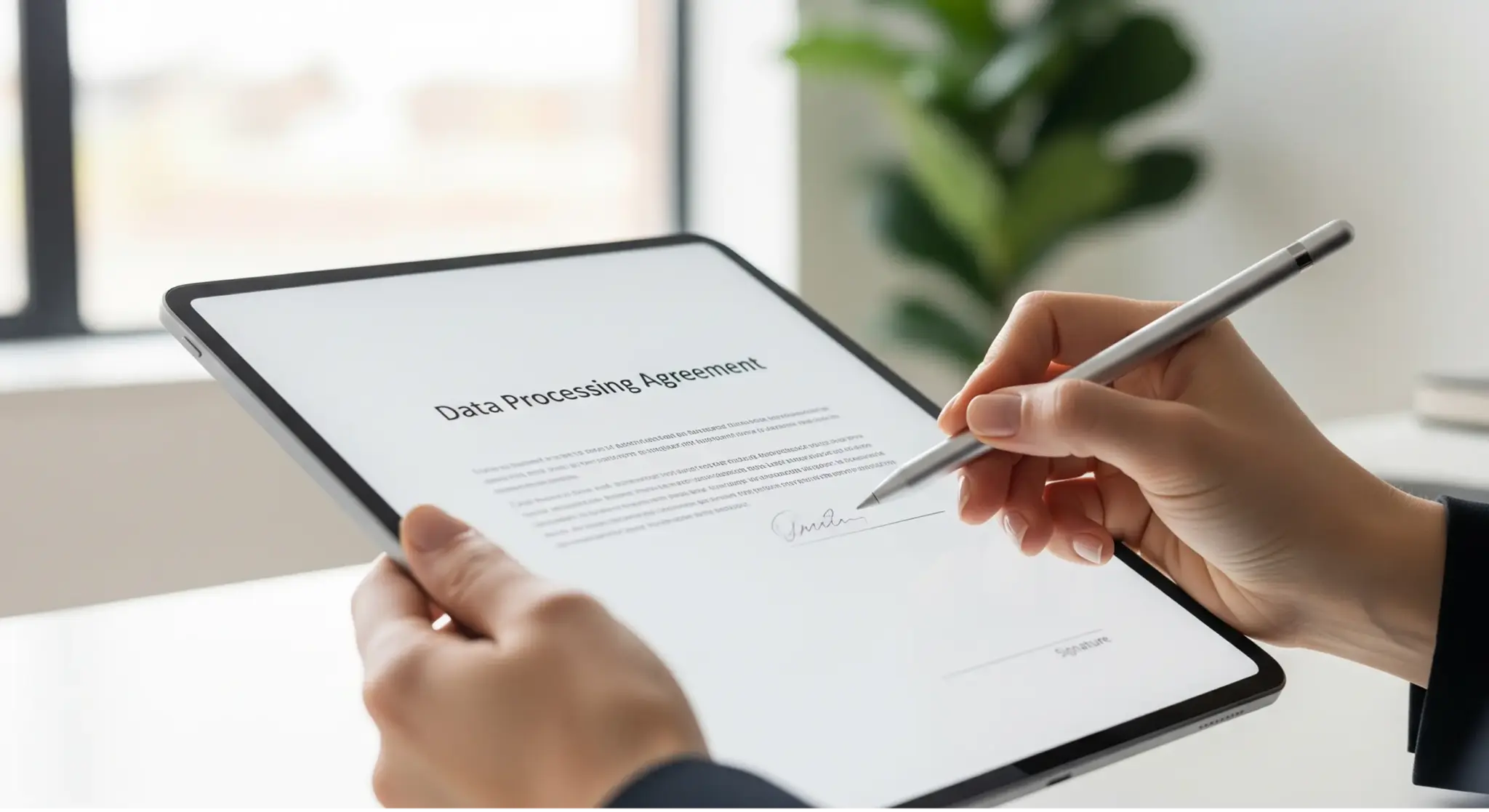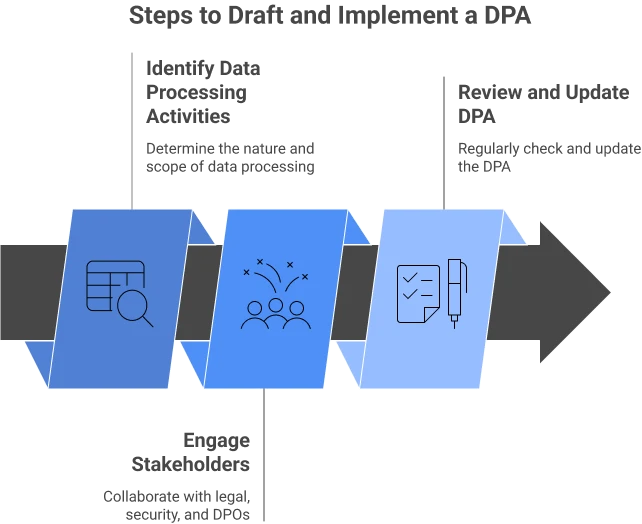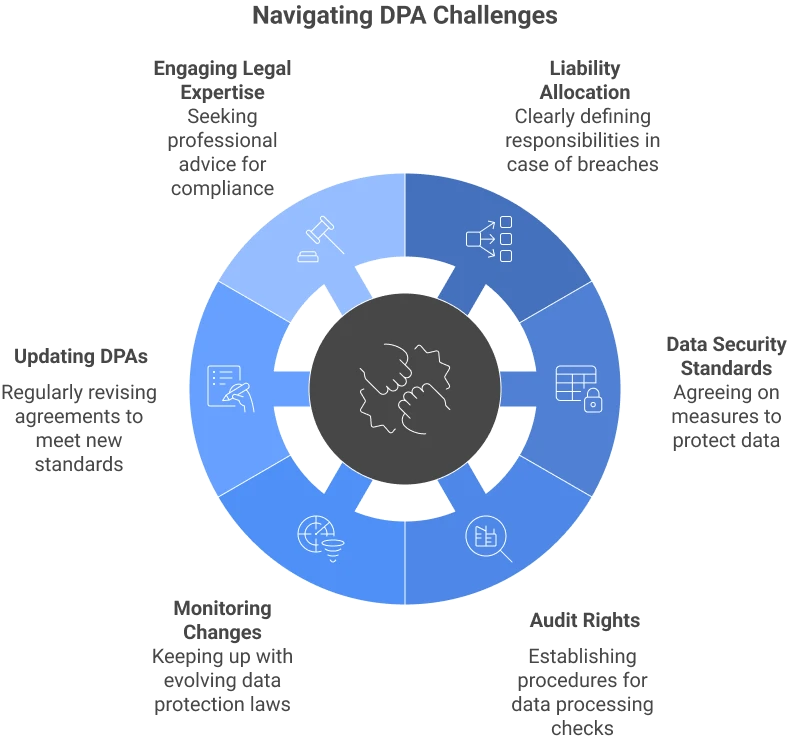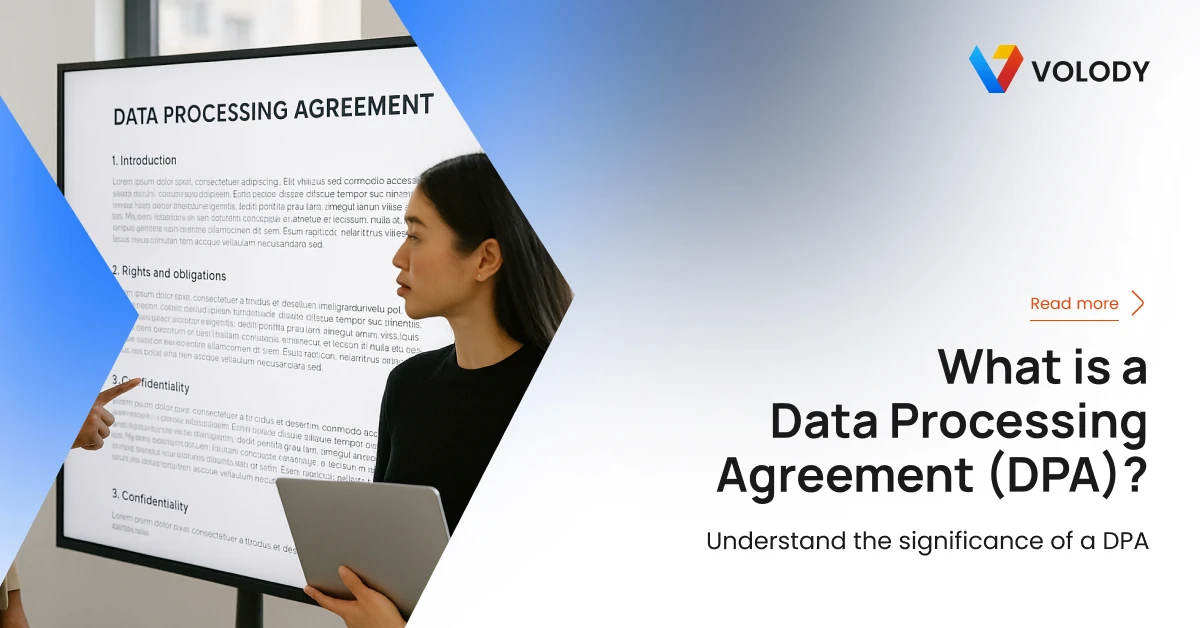Krunal Shah
Aug 7, 2025
Key Highlights
A Data Processing Agreement (DPA) is a legally binding contract outlining data handling, processing, and protection terms between a data controller and a data processor.
DPAs are crucial for GDPR compliance, ensuring data privacy, and mitigating risks associated with data breaches.
Key components of a DPA include defining the scope of data processing, outlining data security measures, and addressing data subject rights.
Drafting and implementing a DPA involves identifying data processing activities, engaging stakeholders, and regularly reviewing and updating the agreement.
Navigating DPA negotiation and compliance challenges requires addressing common issues, staying updated on evolving data protection regulations, and seeking legal counsel when needed.
Introduction
Protecting personal data, including the subject matter of the type of personal data collected, is very important. Many businesses now use third-party services to handle data. Because of this, it is crucial to follow data protection rules, including obtaining the consent of the individual concerned.
This is where Data Processing Agreements (DPAs) are helpful. A DPA is a contract that must be followed by law. It controls how a data controller and a data processor work together. The data controller is the one who decides how personal data is used. The data processor is the one who processes the data for the controller.
Understanding the Basics of Data Processing Agreements
A Data Processing Agreement (DPA) acts as a protection for personal data by outlining the processing of personal data. It makes sure that personal information is handled according to data protection laws. The DPA clearly states the rights of the controller and the duties of both the data controller and the data processor, including reasonable assistance where necessary. It describes how data can be processed, stored, and protected.
The main job of a DPA is to create a clear and responsible system for data processing activities. It sets the tasks for each party involved. This way, personal data is taken care of in a careful manner and follows all legal rules.
Defining Data Processing Agreements in Modern Business
A Data Processing Agreement (DPA) is an important contract in today's business world. It is a legal agreement between a data controller and a data processor. This contract outlines the rules that each party must follow when handling personal data, including the protection of personal data. It helps ensure they follow GDPR data processing regulations and data protection laws like the GDPR, including a well-defined agreement template.
The DPA contains important information such as:
The purpose of the processing
The types of personal data involved
Security measures to protect data
Data privacy protocols
The duration of the processing activities
DPAs help to protect personal information. They are vital for keeping data secure in our digital world.
The Significance of DPAs in Data Protection
DPAs are important for keeping data protection rules in place. These rules are part of international laws, especially the General Data Protection Regulation (GDPR).
A key part of data protection is making sure personal data is secure. DPAs play a big role here. They make organizations use the right technical and organizational measures to reduce the risk of data breaches. This helps keep personal data safe and private.
DPAs also support data subjects, which are the people whose personal data is processed. They explain the rights of these individuals and provide ways for them to use those rights. This includes the rights to access, correct, and delete their data. It also includes the right to limit or oppose the processing of their data.
Related Article: What is Privacy disclosure agreement? A Comprehensive guide
Legal Requirements for DPAs in the United States

While the United Kingdom and the United States do not have one main law for data protection, there are many laws and rules in different sectors. New state privacy laws, like the California Consumer Privacy Act (CCPA), show that data protection is becoming more important in the US.
Since there isn’t a single federal law, the rules for Data Processing Agreements (DPAs) in the US can be complicated. However, there are many specific regulations for different industries. For example, the Health Insurance Portability and Accountability Act (HIPAA) applies to healthcare data and often requires DPAs to help meet the rules.
Overview of U.S. Data Protection Laws Involving DPAs
Many US privacy laws require the use of Data Processing Agreements (DPAs). These laws often target specific areas or kinds of data, like:
HIPAA (Health Insurance Portability and Accountability Act): It protects sensitive health information.
GLBA (Gramm-Leach-Bliley Act): It requires banks and other financial companies to keep customer financial data safe.
COPPA (Children's Online Privacy Protection Act): It ensures online privacy for kids under 13.
Comparing U.S. DPA Requirements with Global Standards
Compared to the European Union's GDPR, which has a broader scope and stricter requirements, US data protection laws are often considered more fragmented and sector-specific.
Feature | US DPA Requirements | EU GDPR DPA Requirements |
Scope | Sector-specific, with emerging state-level laws | Comprehensive, covering all personal data |
Data Subject Rights | Varied, depending on the law | Strong, consistent rights across the EU |
Enforcement | Primarily enforced by sectoral regulators | Enforced by data protection authorities in each member state |
While US data protection regulations are evolving, the EU's GDPR remains a global benchmark for data protection, emphasizing the need for robust data processing agreements that adhere to stringent standards.
Key Components of an Effective Data Processing Agreement
An effective DPA should cover all parts of data processing. It needs to avoid confusion and make sure everyone involved understands their part. It should state the roles and duties of each party. It should also describe the exact data processing activities taking place and the organizational measures used to keep data secure.
Essential Clauses for Comprehensive Coverage
To ensure strong data protection, a Data Processing Agreement (DPA) should include important points like:
Purpose and scope of data processing: This means stating what data will be processed, how long it will be kept, and why it will be used.
Data subject rights: The DPA should explain how the data processor will help people use their rights. This includes rights like accessing, fixing, deleting data, and saying no to processing.
Data transfer mechanisms: If the data goes outside the European Economic Area (EEA) or to places with different data protection laws, the DPA must show how it will keep data safe. This can involve using Standard Contractual Clauses (SCCs).
Data Subject Rights and Obligations
Data subject rights are very important in data protection law. A strong Data Processing Agreement (DPA) makes sure these rights are followed during data processing. The agreement should:
List and explain all key data subject rights. This includes accessing, checking and fixing data, erasing data, limiting processing, and moving data.
Detail the obligations of each party. This means showing how the data controller will help with data subject requests and how the data processor will support the controller in meeting these needs.
Comply with member state law. This includes looking at any extra rules or limits set by the laws of the member state where the data subjects are located.
Technical and Organizational Measures for Data Security
Ensuring the safety of processing is very important. This part of the DPA requires certain security measures, which include:
Technical and organizational measures: This includes things like encryption, controlling access, using pseudonyms, backing up data, and having plans for recovery in case of a disaster.
Monitoring and review: These are processes that check if the security measures are working well over time.
Information security awareness: Training for people who work with data.
Related Article: International Data Privacy Laws: Stay Compliant
Steps to Draft and Implement a DPA

Making a strong and enforceable Data Processing Agreement (DPA) is a step-by-step process. It needs careful thought, clear talks, and teamwork between the data controller and the data processor.
First, you need to figure out what data processing activities will happen. Then, talk with everyone involved to set the terms of the agreement.
Identifying the Scope of Data Processing Activities
The first step in creating a Data Processing Agreement (DPA) is to identify the exact data processing activities.
Determine the nature of the processing: This means listing the types of processing actions done, like collection, storage, analysis, or transfer.
Identify the specific personal data: This involves specifying the types of personal data, such as names, addresses, financial details, or health records.
Document the data processing activities: This means clearly outlining every step of the data processing cycle, from collection to deletion or return.
Engaging Stakeholders in the DPA Process
Good DPA development needs teamwork with important people:
Legal counsel: Get help from legal experts to follow data protection laws.
Information security teams: Work with information security staff to set up the right technical and organizational measures for data security.
Data protection officers (DPOs): Talk to DPOs, if needed, to make sure the DPA fits with the organization’s data protection plan.
Reviewing and Updating DPAs Regularly
DPAs are not fixed documents. They need to be looked at and updated regularly:
Reviewing: It is important to regularly check for any changes in data processing activities, laws, or company policies.
Updating: Changes should be made to stay compliant and to deal with any new risks or issues.
Data protection impact assessments (DPIAs): Carrying out DPIAs helps to assess how big changes to data processing activities could affect data protection. This will help in updating the DPA.
Related Article: Website Privacy Policy: Crafting an Effective Document 101
Navigating Challenges in DPA Negotiation and Compliance

Drafting and putting into action Data Protection Agreements (DPAs) can be tough. This is especially true when trying to align what data controllers and processors want.
During negotiations, there may need to be a balance between following data protection obligations and working efficiently. Compliance means keeping up with changing rules and managing any possible breaches well.
Addressing Common Issues in DPA Discussions
Common issues during DPA negotiations can include:
Liability allocation: This means clearly stating who is responsible if there is a data breach or if someone does not follow the rules.
Data security standards: Both sides need to agree on certain technical and organizational measures to keep data secure.
Audit rights: It's important to decide how often and to what extent audits will take place to check on data processing activities.
Ensuring Compliance with Evolving Data Protection Regulations
Data protection rules always change. It is important to keep up to date so you can stay compliant.
Monitoring changes: Track updates in data protection laws around the world. This includes changes and new laws.
Updating DPAs: Review and update Data Processing Agreements (DPAs) regularly. This helps you meet the newest legal requirements and best practices.
Engaging legal expertise: Get help from legal experts. They can assist you in understanding the complex rules and help you remain compliant.
Conclusion
In conclusion, businesses need to understand and use a Data Processing Agreement (DPA). A DPA helps businesses follow data protection laws. It sets out what each side must do while handling personal data. This makes things clear and keeps data secure. By adding key points and updating the DPA often, companies can lower risks and protect the privacy of data subjects.
Knowing how to handle challenges in DPA discussions and following the rules takes effort and keeping up with new laws. By solving common problems and working with others, businesses can build trust and responsibility in their data processing activities. Stay updated, check your DPA often, and make sure you're following the rules to keep sensitive data safe.
Frequently Asked Questions
What makes a DPA legally binding in the U.S.?
For a Data Processing Agreement (DPA) to be legally valid in the United States, it needs to be a written contract. It must follow the basic rules of contracts, which include an offer, acceptance, consideration, and mutual agreement.
The DPA should also match the laws that apply, including federal ones and state laws like the CCPA, as well as align with any relevant guidelines set by the European Commission. Lastly, it should clearly explain the obligations regarding data protection for both the data controller and the service provider.
How often should a DPA be reviewed or updated?
DPAs should be reviewed at least once a year. You should also check them when there are big changes in data processing activities or data protection laws that matter to you. This helps you stay compliant with GDPR and meet new legal needs or good practices. It’s a good idea to provide some help in updating the processor. They usually know a lot about these things.
Can small businesses be exempt from having a DPA?
Small businesses usually need a Data Processing Agreement (DPA) if they handle data and use third-party data processors. Most privacy laws, like the California Privacy Rights Act (CPRA) and CCPA, look at what organizations do, not how big they are.
Small businesses that manage personal information should get legal help to understand their data protection obligations, especially when considering the role of third parties in the processing of that information, including the potential risks of a personal data breach.
What are the penalties for non-compliance with DPA requirements?
Penalties for not following DPA rules can be very different. It depends on where you are and which data protection authorities are involved. Punishments can be large fines, damage to one’s reputation, legal action taken by data subjects, or stopping data processing activities. The supervisory authority in charge of these laws usually decides what the penalties will be.
About the Company
Volody AI CLM is an Agentic AI-powered Contract Lifecycle Management platform designed to eliminate manual contracting tasks, automate complex workflows, and deliver actionable insights. As a one-stop shop for all contract activities, it covers drafting, collaboration, negotiation, approvals, e-signature, compliance tracking, and renewals. Built with enterprise-grade security and no-code configuration, it meets the needs of the most complex global organizations. Volody AI CLM also includes AI-driven contract review and risk analysis, helping teams detect issues early and optimize terms. Trusted by Fortune 500 companies, high-growth startups, and government entities, it transforms contracts into strategic, data-driven business assets.








